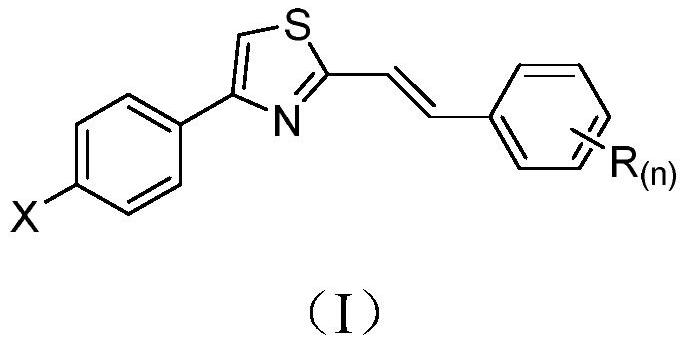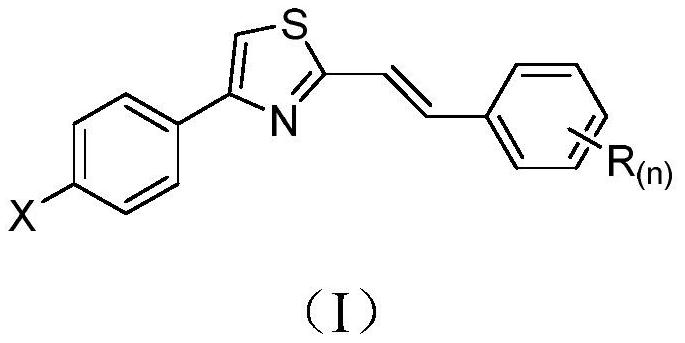4-(4-halogenated phenyl)-2-(substituted styryl) thiazole compound and application thereof
A technology of styryl and halogenated phenyl, which is applied in the field of 4--2-thiazole compounds, can solve the problems of structure and biological activity that have not been reported in literature, and achieve the effect of simple preparation process
- Summary
- Abstract
- Description
- Claims
- Application Information
AI Technical Summary
Problems solved by technology
Method used
Image
Examples
Embodiment 1
[0025] The synthesis of embodiment 1 compound Ia (X=Br, R(n)=hydrogen):
[0026]Add 2-(bromomethyl)-4-(4-bromophenyl)thiazole (3.3g, 10mmol) and triethyl phosphite (4.1g, 25mmol) into a 100mL three-necked flask, heat to 140°C for reaction, TLC The progress of the reaction was detected, and the reaction was completed after about 4 hours. Concentrate and remove excess triethyl phosphite to obtain a concentrated solution; add DMF (2.9g, 40mmol), benzaldehyde (1.1g, 10mmol) and sodium hydroxide (0.4g, 10mmol) to the resulting concentrated solution at room temperature reaction. The reaction process was detected by TLC, and the reaction was completed in about 4 hours. Then, the reaction solution was poured into ice water (110 mL), stirred, and a solid precipitated, filtered, and the filter cake was recrystallized with ethyl acetate to obtain 1.76 g of a yellow solid, which was (E)- 4-(4-Bromophenyl)-2-styrylthiazole, the calculated yield was 51.4%. m.p.:168~170℃;
[0027] 1 H N...
Embodiment 2
[0028] Synthesis of Example 2 Compound Ib (X=Br, R(n)=o-methoxy):
[0029] Add 2-(bromomethyl)-4-(4-bromophenyl)thiazole (3.3g, 10mmol) and triethyl phosphite (4.1g, 25mmol) into a 100mL three-necked flask, heat to 145°C for reaction, TLC The progress of the reaction was detected, and the reaction was completed after about 4 hours. Concentrate and remove excess triethyl phosphite to obtain a concentrated solution; add DMF (4.0g, 55mmol), o-methoxybenzaldehyde (1.36g, 10mmol) and sodium hydroxide (1.3g, 32mmol) to the resulting concentrated solution ) react at room temperature. The reaction process was detected by TLC, and the reaction was completed in about 3.5 hours. Then, the reaction solution was poured into ice water (130 mL), stirred, and solids were precipitated, filtered, and the filter cake was weighed with a mixture of ethyl acetate and petroleum ether with a volume ratio of 1:2. Crystallization gave 2.02 g of a yellow solid, namely (E)-4-(4-bromophenyl)-2-(2-methox...
Embodiment 3
[0031] Synthesis of Example 3 Compound Ic (X=Br, R(n)=m-methoxy):
[0032] Add 2-(bromomethyl)-4-(4-bromophenyl)thiazole (3.3g, 10mmol) and triethyl phosphite (5.0g, 30mmol) into a 100mL three-necked flask, heat to 150°C for reaction, TLC The progress of the reaction was detected, and the reaction was completed after about 5 hours. Concentrate and remove excess triethyl phosphite to obtain a concentrated solution; add DMF (3.7g, 50mmol), m-methoxybenzaldehyde (1.63g, 12mmol) and sodium hydroxide (0.9g, 22mmol) to the resulting concentrated solution ) react at room temperature. The reaction process was detected by TLC, and the reaction was completed in about 4 hours. Then, the reaction solution was poured into ice water (165 mL), stirred, and a solid precipitated, filtered, and the filter cake was recrystallized with ethyl acetate to obtain 1.8 g of a yellow solid, which was (E)- 4-(4-Bromophenyl)-2-(3-methoxystyryl)thiazole, the calculated yield was 48.3%. m.p.:112~113℃;
...
PUM
 Login to View More
Login to View More Abstract
Description
Claims
Application Information
 Login to View More
Login to View More - R&D
- Intellectual Property
- Life Sciences
- Materials
- Tech Scout
- Unparalleled Data Quality
- Higher Quality Content
- 60% Fewer Hallucinations
Browse by: Latest US Patents, China's latest patents, Technical Efficacy Thesaurus, Application Domain, Technology Topic, Popular Technical Reports.
© 2025 PatSnap. All rights reserved.Legal|Privacy policy|Modern Slavery Act Transparency Statement|Sitemap|About US| Contact US: help@patsnap.com



